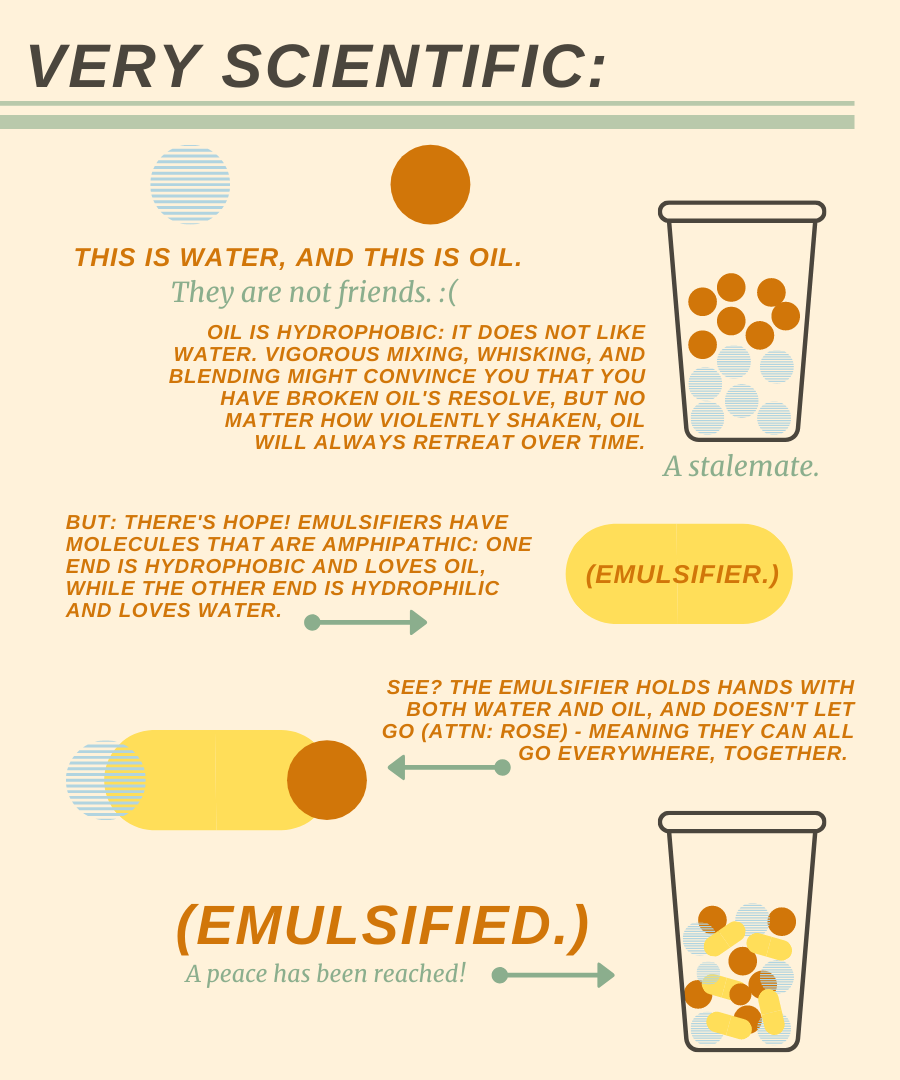Finding the Right Emulsifier In Food for Your Cooking Goals
Discover the Reasons You Need an Emulsifier in Food for Improved Structure and Stability
Emulsifiers play a necessary duty in food preparation, guaranteeing that components combine perfectly, especially those that generally do not mix well, such as oil and water. Their visibility boosts structure, security, and general high quality in a selection of cooking applications. This not just enhances the sensory experience however also prolongs the service life of products. Understanding their relevance can lead to better cooking results, however what specifically makes an emulsifier crucial in modern-day cuisine?
Comprehending Emulsifiers: What They Are and How They Function
Emulsifiers play an essential role in the food industry by enabling the secure blending of ingredients that commonly do not mix, such as oil and water. These substances, which can be natural or artificial, consist of particles with a hydrophilic (water-attracting) and a hydrophobic (water-repelling) end. When included to a mixture, emulsifiers decrease the surface area stress in between the 2 phases, enabling them to integrate efficiently. Common examples consist of lecithin, located in egg yolks, and mono- and diglycerides, typically acquired from fats.
Along with enhancing appearance and mouthfeel, emulsifiers add to the service life of products by protecting against separation, guaranteeing constant quality gradually. They likewise promote the circulation of flavors and nutrients throughout the combination, enhancing general sensory properties. Recognizing the performance of emulsifiers is important for food manufacturers seeking to create steady, high-grade items that satisfy consumer expectations.

The Role of Emulsifiers in Salad Dressings
In salad dressings, the incorporation of emulsifiers is important for attaining an uniform appearance and stopping the splitting up of oil and vinegar or various other liquid components. Emulsifiers, such as lecithin or mustard, promote the mixing of immiscible parts, creating a secure solution. This security is crucial for both the look and mouthfeel of the dressing, enhancing the overall dining experience.
When emulsifiers are utilized, salad dressings keep their consistency and do not different, which can be unattractive to customers. The existence of emulsifiers likewise permits a smoother application on salads, ensuring also distribution of tastes. Additionally, emulsifiers can improve the service life of dressings by reducing the possibility of separation with time. In general, the duty of emulsifiers in salad dressings is crucial for both visual charm and practical performance, making them an important ingredient in the cooking globe.

Enhancing Baked Goods With Emulsifiers
Although typically neglected, emulsifiers play a vital duty in enhancing the texture and top quality of baked goods. These active ingredients assist to stabilize the blend of liquids and fats, causing a consistent dough that advertises also baking. By boosting the dough's structure, emulsifiers add to a softer crumb and an extra soft structure, making items like cakes, muffins, and bread more enjoyable.
Furthermore, emulsifiers can extend the life span of baked products by lowering staling. They preserve moisture, protecting against the product from ending up being completely dry and hard with time. In addition, emulsifiers promote better aeration during mixing, leading to boosted volume and agility in the end product.
Integrating emulsifiers makes it possible for bakers to attain uniformity in top quality, guaranteeing that each batch meets customer assumptions. Overall, using emulsifiers is important for creating baked goods that are not just enticing but also have a gratifying mouthfeel and longer freshness.
Developing Creamy Sauces: The Magic of Emulsifiers
Emulsifiers play a crucial role in the culinary globe by facilitating the mixing of ingredients that normally do not blend, such as oil and water. Different kinds of emulsifiers, from lecithin to mono- and diglycerides, each contribute special residential properties that enhance the structure and stability of sauces. Understanding these emulsifiers and their advantages can transform easy components right into irresistibly velvety sauces.
Emulsifiers Defined Merely
The art of developing velvety sauces relies greatly on the function of emulsifiers. Emulsifiers are substances that facilitate the blending of two immiscible fluids, such as oil and water, which would otherwise divide. By lowering the surface area stress in between these liquids, emulsifiers develop a secure blend, resulting in a regular and smooth structure. Common examples include lecithin, found in egg yolks, and mustard, both of which help integrate fats right into sauces effortlessly. These components not just enhance the mouthfeel but likewise add to the overall stability of the sauce. Understanding the feature of emulsifiers is necessary for chefs and home chefs alike, as they are essential in attaining the wanted creaminess and cohesiveness in cooking productions.
Sorts of Emulsifiers
Numerous types of emulsifiers play crucial functions in culinary applications, each offering unique residential or commercial properties that add to the production of velvety sauces - Emulsifier In Food. Lecithin, often obtained from egg yolks or soybeans, acts as an all-natural emulsifier, effectively blending oil and water. Another usual emulsifier, mustard, not only enhances taste but content also stabilizes emulsions because of its mucilage material. Furthermore, xanthan periodontal, a polysaccharide produced by fermentation, supplies enlarging and supporting residential or commercial properties, making it suitable for creamy structures. Mono- and diglycerides, typically discovered in commercial products, assist in emulsification by lowering surface area tension between active ingredients. Understanding these varied emulsifiers permits cooks to attain the desired uniformity and mouthfeel in their sauces, improving the general dining experience
Advantages for Sauces
While creating velvety sauces may appear like a simple job, the role of emulsifiers is important in attaining the ideal structure and security. Emulsifiers, such as lecithin or mustard, assist in the blending of oil and water, stopping webpage separation and making sure a smooth uniformity. This property is particularly useful in sauces like vinaigrettes, mayonnaise, and velvety dressings, where a consistent appearance boosts both appearance and mouthfeel. Additionally, emulsifiers can enhance the sauce's shelf-life by stabilizing ingredients, decreasing the possibility of wasting. Their ability to boost taste launch also makes recipes more enjoyable, as the fats in sauces carry and intensify taste. Ultimately, incorporating emulsifiers changes average sauces into abundant, velvety thrills that boost cooking experiences.
Emulsifiers in Dairy Products: Accomplishing Consistency
Emulsifiers play an important role in milk items, ensuring a stable combination of fats and water that boosts texture and mouthfeel. In items such as milk, cheese, and lotion, emulsifiers help keep consistency by stopping separation, which can bring about undesirable structures. By maintaining the emulsions, these components permit a consistent circulation of fat, resulting in a creamier and smoother product.
Typical emulsifiers utilized in dairy products include lecithin, mono- and diglycerides, and sodium stearoyl lactylate. These compounds reduce surface area stress between fat and water, helping with a secure blend. Their presence not only enhances the sensory experience however also prolongs the rack life of milk products by decreasing splitting up throughout storage.

The Importance of Texture in Culinary Discussion
Structure plays an important function in cooking presentation, influencing both visual charm and general eating experience. An unified mouthfeel can boost a dish, making it extra pleasurable and unforgettable for the consumer. Furthermore, consistency in structure warranties that expectations are satisfied, contributing to a well-rounded gastronomic experience.
Aesthetic Allure Matters
Although typically neglected, the aesthetic charm of food significantly influences the straight from the source overall eating experience. A dish's presentation can evoke emotions, stimulate appetites, and create expectancy for flavors yet to be tasted. Shades, plans, and shapes add considerably to this aesthetic enjoyment. Vibrant colors can improve a meal's beauty, making it much more welcoming. Furthermore, the appearances attained with making use of emulsifiers can produce enticing contrasts, such as luscious sauces alongside crisp vegetables. Such combinations not only enhance visual interest but also signal quality and focus to information. Eventually, a well-presented recipe reflects the cook's skill and imagination, making it more probable to leave a long-term impact on diners and boost the dish to an art type.
Mouthfeel Boosts Experience
An unified mix of structures can considerably boost the culinary experience, changing a straightforward meal into a remarkable banquet. Mouthfeel plays a vital function in how food is viewed, affecting flavor assumption and general satisfaction. When structures are attentively combined-- such as creamy sauces covering crisp vegetables or tender meats coupled with crispy garnishes-- the sensory experience ends up being more engaging and complex. Emulsifiers facilitate this interaction by maintaining mixes, making sure a consistent mouthfeel that boosts satisfaction. The comparison between soft and crispy, smooth and gritty, captivates the palate, urging diners to relish each bite. Eventually, interest to mouthfeel not only enriches the eating experience however additionally strengthens the virtuosity entailed in cooking discussion, making it an essential element of food design.
Uniformity Is Trick
The interplay of appearances in food not only heightens mouthfeel however likewise emphasizes the significance of uniformity in culinary discussion. Regular structure assurances that each bite offers a foreseeable experience, vital for both pleasure and fulfillment. When recipes display harmony in appearance, they convey professionalism and attention to information, improving the total charm. Emulsifiers play a considerable role in accomplishing this consistency by maintaining blends and preventing splitting up, which can lead to unfavorable variations. This security permits cooks to create meals that not only taste remarkable however also look aesthetically appealing. Essentially, an unified appearance is indispensable to the eating experience, as it affects assumptions of top quality and craftsmanship in food preparation.
Exactly how to Pick the Right Emulsifier for Your Dishes
Exactly how can a chef identify the optimal emulsifier for a certain recipe? The selection pivots on the dish's components and desired outcome. Initially, cooks need to take into consideration the kind of emulsion they aim to develop-- either oil-in-water or water-in-oil. For oil-in-water solutions, common emulsifiers consist of lecithin and mono- and diglycerides, while water-in-oil solutions may take advantage of beeswax or sorbitan esters.
Next, the cook must assess the capability required. Some emulsifiers give security at different temperatures, while others enhance appearance or mouthfeel. In addition, nutritional limitations can influence the option; for instance, plant-based options like xanthan periodontal are suitable for vegan recipes.
Finally, examining various emulsifiers in tiny batches allows chefs to observe their impacts on texture and stability, guaranteeing the final item fulfills assumptions. By attentively choosing the right emulsifier, cooks can significantly enhance their cooking productions.
Often Asked Questions
Are Emulsifiers Safe for People With Allergic reactions?
Emulsifiers can be secure for individuals with allergic reactions, depending upon the particular emulsifier utilized. Nonetheless, those with allergic reactions must constantly check ingredient labels and talk to medical care professionals to prevent potential allergies.
Can Emulsifiers Affect the Nutritional Worth of Food?
Emulsifiers can influence the nutritional worth of food, possibly altering the absorption of nutrients (Emulsifier In Food). The extent of this effect varies depending on the type of emulsifier made use of and the general food structure.
Exactly How Do Emulsifiers Influence Food Service Life?
Emulsifiers can boost food rack life by supporting mixtures, avoiding separation and oxidation. This results in longer-lasting products, as emulsifiers aid preserve constant appearance and flavor, consequently decreasing spoilage and extending usability.
Exist Natural Alternatives to Synthetic Emulsifiers?
Yes, there are all-natural choices to synthetic emulsifiers. Components like lecithin from eggs or soy, starches, and specific gum tissues can properly stabilize solutions while giving a more wholesome choice for customers seeking healthy food products.
Do Emulsifiers Modify the Taste of Food Products?
Emulsifiers usually do not modify the preference of food substantially. Their key function is to boost appearance and security, allowing tastes to continue to be intact while enhancing total mouthfeel and uniformity in numerous cooking applications.
Frequently neglected, emulsifiers play an important duty in improving the structure and quality of baked products. Various kinds of emulsifiers, from lecithin to mono- and diglycerides, each add one-of-a-kind homes that boost the structure and security of sauces. Emulsifiers play an important duty in dairy items, guaranteeing a secure blend of fats and water that boosts appearance and mouthfeel. Some emulsifiers provide stability at numerous temperature levels, while others enhance appearance or mouthfeel. Emulsifiers can be safe for people with allergies, depending on the certain emulsifier utilized.